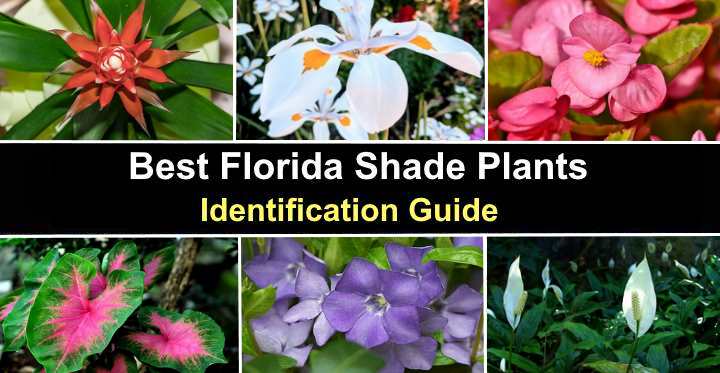For creating a stunning garden landscape, knowing the finest shade plants for Florida is key. Many plants struggle in direct sunlight due to Florida’s lengthy, hot summer days and humid environment. In addition, not all flowering plants, perennials, shrubs, and ground cover plants do well in shaded environments. As a result, selecting the finest Florida shade plants may improve your home’s appearance.
Shade-tolerant plants should ideally flourish in less than four hours of direct sunlight every day. Several shade-loving blooming shrubs, such as azaleas and hydrangeas, feature vibrant flowers and evergreen leaves. In addition, along shrub borders, low-growing plants like periwinkle and caladiums are ideal for the shade.
In Florida’s hot and humid environment, what are the best shade plants to cultivate? The best blooming plants and shrubs in Florida are listed in this article.
What are Shade Plants?
In gardens that receive little direct sunlight during the day, shade plants may thrive. Shade-loving plants thrive as understory plants beneath a shaded wall, in a north-facing garden, or in constant shadows and have few light requirements. Dappled shade is ideal for some Florida plants, while ambient light is sufficient for others. Of course, to grow and photosynthesize, all plants need some amount of light. For shade-tolerant plants and shrubs, here are descriptions of light conditions:
- Heavy shade— Even when they receive almost no direct sunlight, plants perform well.
- Full shade— Plants that thrive and bloom in one-hour environments include ornaments, evergreens, and perennials. Permanent shade from buildings, huge trees, and shrubs is a common occurrence.
- Partial shade— When they get around two hours of sunlight every day, these shade-tolerant plants perform well.
- Light shade— Plants, particularly those in the morning sun, flourish in three to five hours of sunlight.
Growing Zones for Shade Plants in Florida
It’s important to verify that the shrub, perennial plant, evergreen bush, or flowering ornamental is in the proper growing zone before selecting which shade plants to cultivate in a Florida garden. Several plants will struggle in Northern Florida if they are intolerant of the cold. Plants in USDA zone 9, however, will perish in the heat and humidity of southern Florida and the Florida Keys.
The following is a breakdown of Florida’s growing zones:
- Florida Zone 8— In the panhandle of Florida, northwest of it. Pensacola, Tallahassee, and Panama City are among the cities in zone 8. The lowest average winter temperature is 20 degrees Fahrenheit (-6.6 degrees Celsius).
- Florida Zone 9— From east to west, this is the most populated section of Florida. Orlando, Jacksonville, and Tampa are all in the 9th zone. The lowest temperature recorded in the winter months is 25°F (-3.8°C).
- Florida Zone 10— From Lake Okeechobee to Florida’s south coast. Fort Lauderdale, Cape Coral, and Naples are all in zone 10. The lowest average winter temperature is 30°F to 35°F (1.1°C to 1.7°C).
- Florida Zone 11— The Florida Keys and sections of the mainland on the eastern coast are found at this point, making it Florida’s southernmost tip.
It’s worth noting that certain plants may perform better in two zones when depending on climatic conditions, elevation, and proximity to the shore.
How to Choose Shade Plants in Florida
Florida shade plants add color and beauty to your garden by producing colorful blooms and leaves. You’ll need to weigh a few factors when selecting suitable plants for growing in shaded areas, the most important of which is sun tolerance. Several shade plants need at least a few hours of sunlight, while others need permanent shade.
The cold-hardiness zone, soil type, and watering requirements are all other factors that influence shade-tolerant plants in Florida. In addition, the size of the shrub, trimming, and whether or not it blooms must be taken into consideration.
Shade Plants in Florida (with Pictures) — Identification
Shade plants that grow from zone 8 through 11 are worthy of consideration. Blossom shade plants, low-growing shade plants, tall shade plants, and shrubby shadow plants are the four types of shadow-loving flowers. They all thrive in Florida’s unique environment.
Flowering Shade Plants For Florida
Bolivian Sunset (Gloxinia sylvatica)

The blooming shade plant Bolivian Sunset is suitable for Florida gardens. Bolivian sunset is a tubular bloom blooming shrub that thrives in filtered sun or dappled shade. The glossy dark green lanceolate leaves of the lovely leafy shrub are set on elegant red stems. This warm, humid plant thrives in the winter and grows up to 2 feet (60 cm) tall and broad. It’s a great option for shady Florida yards.
In Florida, the Bolivian sunset plant is a low-growing plant that has several landscape applications. For adding color to rock gardens or shaded borders and mixed beds, the Bolivian sunset plant is ideal. Other Florida shade plants perform well with it as well.
Size: 24” (60 cm) tall and wide.
Sun exposure: Partial shade
USDA growing zones: 9 to 11
Pinwheel Jasmine (Gardenia jasminoides ‘Pinwheel’)

Pinwheel Jasmine is a cool-hardy, shade tolerant, blooming plant that thrives as far south as the Florida Keys. It is an attractive blooming shrub for partial shade. The glitzy green lance-shaped leaves and white-petalled blooms of the lovely evergreen plant fragrance are stunning.
The bushy shrub grows up to 4 feet (1.2 meters) tall and wide, and is also known as pinwheel cape jasmine. The ideal all-rounder for Florida gardens is pinwheel jasmine. In full sun and partial shade, the lustrous shrub performs equally well. Moreover, as a flowering hedge, container plant, or rear of the bed shrub, evergreen bushes are ideal.
Size: 4 ft. (1.2) tall and wide
Sun exposure: Partial sun
USDA growing zones: 6 to 11
African Iris (Dietes vegeta or Dietes iridioides)

Potted African iris may be grown as a foundation plant for dappled shade on a partially shaded porch. White circular petals with purple and yellow hues make up the lily-like blooms. The shade-tolerant clumping plant, also known as fortnight lily or morea iris, has long, slender pointed leaves that grow up to 2 feet (60 cm) tall.
Damp, soggy soil and occasional drought are tolerable for African iris plants. In Florida gardens, long, narrow grass-like blades; white blooms; and fragrant scents make excellent borders or foundation plants.
Size: 24” (60 cm) tall and wide
Sun exposure: Full sun to partial shade
USDA growing zones: 9 to 11
Begonias
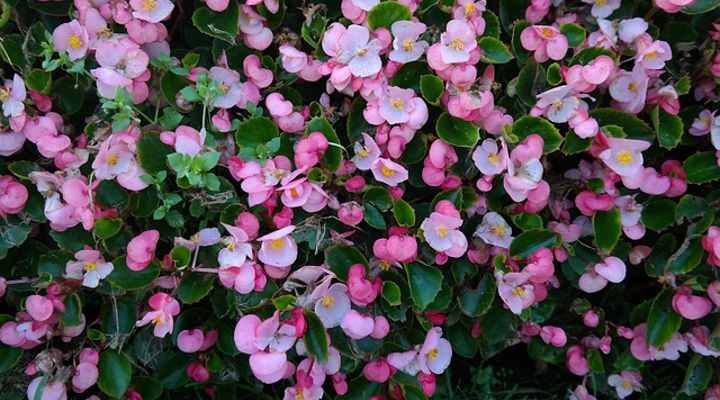
Wax begonias, cane begonias, and rhizomatous begonias are among the most vibrant flowers for partial shade or dappled light in Florida. Filtered sunlight or partial shade are optimal for flowering begonias. The vibrant leaves and spectacular clusters of orange, white, red, and pink blooms make the attractive plants famous.
In all areas of Florida, begonias may be grown outdoors. Begonias, on the other hand, are only suited for zones 10 and 11 in some varieties. Your garden’s shaded area will be brightened up by the lovely bushy flowering plants. Moreover, they are incredibly easy to take care of.
Size: Up to 24” (60 cm) tall and wide
Sun exposure: Partial shade
USDA growing zones: 9 to 11
Bromeliads
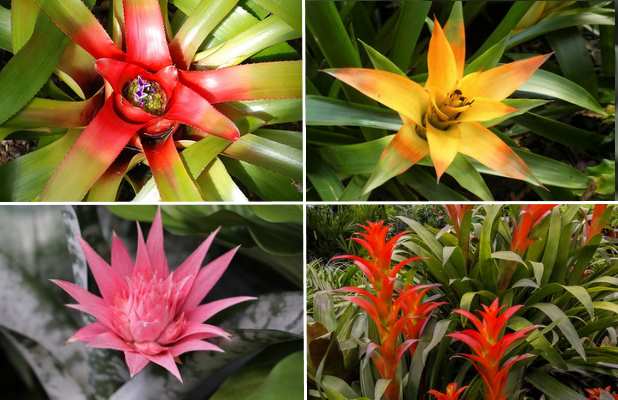
Bromeliads are lovely-colored tropical plants that thrive in frost-free parts of Florida and brighten up south Florida landscapes. The thick leaves of the eye-catching colorful plants form a rosette shape. Green and gold or deep red leaves may be found in the color spectrum. Many bromeliads also feature variegated or multi-color leaves in addition to their unique flowers.
The showy flowers on bromeliads are a unique characteristic, with a long upright stem emerging from the plant’s center. Spiked petals or bracts with arching tips make up the majority of rosette flowers. Bright red, vibrant pink, golden yellow, and a variety of purple hues are among the bromeliad blooms.
Size: From 1” to 36” (2.5 – 90 cm)
Sun exposure: Deep shade (however, check the individual plant for light tolerance)
USDA growing zones: 10 and 11
Low Growing Shade Plants For Florida
Periwinkle (Vinca)

Periwinkle plants are perfect for Florida gardens because of their trailing nature. They thrive in partial to deep shade. For full-shade ground cover, choose perennial spreading plants. Purple flowers are characteristic of low-growing plants, however white, blue, red, and pink hues may also be seen.
In Florida gardens, periwinkle plants should reach a height of 4″ to 24″ (10 – 60 cm). Periwinkle plants are excellent for slopes, underplanting shrubs, and as ground cover. They are suited for difficult landscape situations because of their glossy dark green leaves, star-shaped purple blooms, and tolerance of complete shade.
Size: 4” to 24” (10 – 60 cm)
Sun exposure: Full sun to full shade
USDA growing zones: 4 to 9, although some periwinkle plants are suitable for zone 10
Peace Lily (Spathiphyllum)

In the southern coast of Florida, grow peace lilies in a shady environment with moist soil. The bright white spathe blooms and glossy green lanceolate leaves of the herbaceous perennial peace lily plants are well-known. Peace lilies are only suitable for growing in southern Florida since they bloom in the garden in USDA zones 11 and 12.
Peace lilies are not real lilies, despite their name. At temperatures ranging from 68°F to 85°F (20°C to 30°C), and at night, the flowering plants bloom. Florida plants that prefer the shade grow to be 1 to 6 feet (0.3 to 1.8 meters) tall. The indoor plants that don’t need sunlight are listed as peace lilies.
Size: Up to 6 ft. (1.8 m) tall and 5 ft. (1.5 m) wide
Sun exposure: Partial shade to deep shade
USDA growing zones: 11 and 12
Caladiums

Caladium is a collection of low-growing plants that flourish in shady, humid Florida gardens. It includes caladiums and other tropical flowers. Outside, most caladium plants prefer full shade. Caladiums are recognized for their lovely green, pink, red, and white heart-shaped leaves that are also known as angel wings.
The colors of caladium leaves are more vibrant when growing in shaded conditions. Depending on the cultivar, caladiums grow between 6 and 24 inches (15 and 60 cm) tall. Caladiums are blooming plants that produce a solitary flower comparable to peace lilies, despite being grown for their beautiful leaves.
Size: Up to 24” (60 cm) tall.
Sun exposure: Partial shade to full shade
USDA growing zones: 10 to 12
Asiatic Jasmine (Trachelospermum asiaticum)
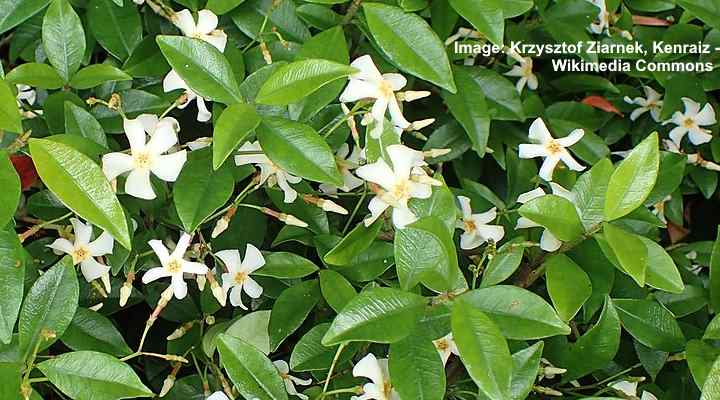
Asiatic jasmine is a low-growing evergreen plant that thrives in hot, humid weather and requires little upkeep. Dainty jasmine-like, pinwheel white flowers bloom on the low-maintenance ground cover plant, which has glossy green lanceolate leaves. Asiatic jasmine can grow up to 18 inches (45 centimeters) tall and 36 inches (90 centimeters) broad.
In Florida landscapes where turf grass doesn’t grow, planting Asian jasmine is popular. The spreading evergreen plant flourishes in partial shade and doesn’t like much sunlight. Because it is tolerant of salty air, you may also successfully grow Asiatic jasmines in coastal Florida.
Size: 6” to 18” (15 – 45 cm) tall and 36” (90 cm) wide
Sun exposure: Partial shade
USDA growing zones: 7 to 11
Variegated Ginger (Alpinia zerumbet ‘Variegata’)

Variegated ginger is a magnificent shade-tolerant plant for south Florida gardens that may be cultivated outdoors. The yellow and green variegated lance-shaped leaves, as well as clusters of fragrant bell-shaped blooms, distinguish the leafy, clumping plant. The 3 to 6 foot (1 to 2 m) tall and 8 foot (2.4 m) broad spectacular low-growing tropical shade plant grows. In the districts of 10 and 11, variegated ginger thrives in southern Florida.
Plant it in a container and overwinter it indoors if you want to grow it outdoors in USDA zones 8 and 9. Variegated ginger may be used as a specimen shrub, front of house shrub, background for smaller plants, or around a palm tree in Florida.
Size: 3 to 6 ft. (1 – 2 m) tall and 8 ft. (2.4 m) wide
Sun exposure: Full sun to partial shade
USDA growing zones: 8 to 10
Tall Shade Plants For Florida
Princess Flower (Tibouchina urvilleana)
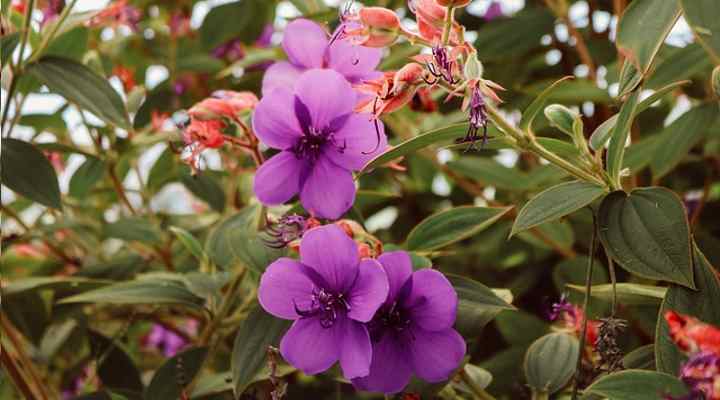
Princess flower is an evergreen tropical shrub that thrives in partial sun to partial shade and is also known as glory bush. In warm, subtropical environments, the tall flowering plant grows up to 8 feet (2.4 meters). The gorgeous plant is distinguished by its spectacular purple blooms, huge ovate leaves, and drought tolerance.
Size: 6 to 8 ft. (1.8 – 2.4 m)
Sun exposure: Full sun to partial shade (two to six hours daily)
USDA growing zones: 9 – 11
Firespike (Odontonema cuspidatum)

Firespike is a leafy shrub with clusters of crimson tubular flowers that can withstand partial shade in Florida. Firespike grows between 4 and 6 feet (1.2 and 1.8 meters) tall and thrives throughout Florida. The crimson flower spikes of the clumping herbaceous plant contrast with the lovely lanceolate green leaves, making it an appealing feature.
Size: 4 and 6 ft. (1.2 – 1.8 m) tall and 2 to 3 ft. (0.6 – 1 m) wide
Sun exposure: Partial sun or partial shade
USDA growing zones: 8 to 11
Shrubby Shade Plants For Florida
Jacobinia (Justicia carnea)

Jacobinia is a blooming shade plant with colorful blooms that grows upright. The evergreen flowering plant brightens up home gardens by blooming all year. flowering evergreen hedges, container plants, and flowering shrubs in shade gardens are all examples of landscape uses for jacobinia.
Size: 3 to 6 ft. (1 – 1.8 m) tall and up to 3 ft. (1 m) wide
Sun exposure: Partial to full shade
USDA growing zones: 9 to 11
Croton
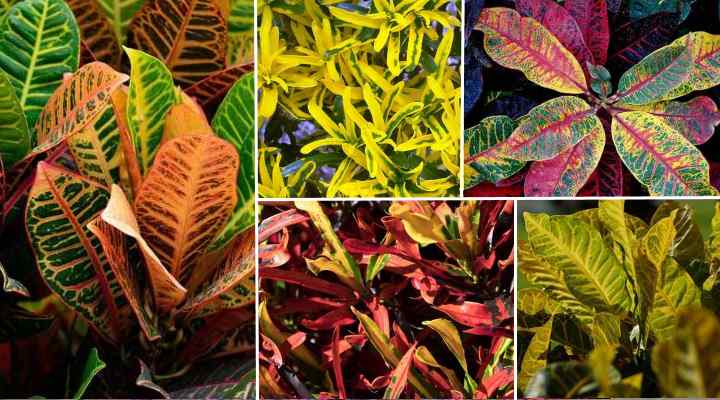
Croton plants, which include several cultivars, thrive in Central and South Florida and prefer partial shade. Green, red, orange, and yellow hues of thick, leathery leaves characterize the gorgeous shrubby plants. Shade-tolerant bushes may reach 10 feet (3 meters) in height, although there are also dwarf forms that make excellent small gardens and containers.
Size: 2 to 10 ft. (0.6 to 3 m) tall depending on the cultivar
Sun exposure: Light shade to partial shade
USDA growing zones: 9 to 11
Oakleaf Hydrangea
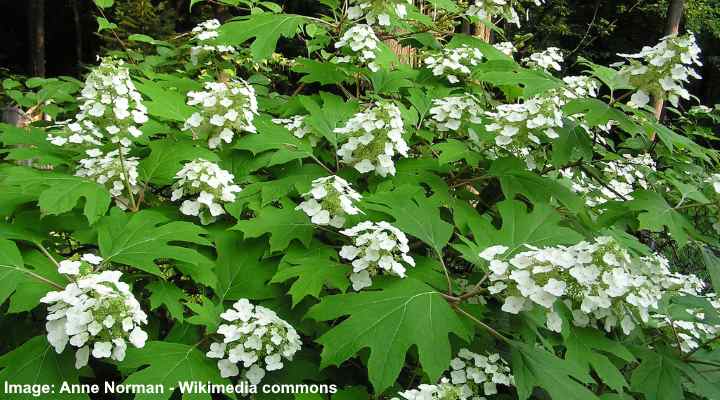
Oakleaf hydrangea is a shade-loving shrub that may be found in the state of Florida. The bright bronze or purple fall foliage and big clusters of white, conical blooms distinguish the deciduous big shade-loving shrub. The oakleaf hydrangea performs best in Florida in partial to full shade, despite its preference for the sun.
Size: 6 to 8 ft. (1.6 – 2.4 m) tall and wide
Sun exposure: Partial shade
USDA growing zones: 5 to 9
Dwarf Azalea

In partial shade gardens throughout Florida, dwarf azalea shrubs add a bright flourish. Between February and April, the evergreen plants bloom, and then periodically throughout the year. The dramatic trumpet-like blossoms of dwarf azaleas, which have protruding stamens, are well-known.
For all regions of Florida, there are many azalea cultivars and hybrids to choose from. Azaleas will continue to produce beautiful blooms all summer and in the mild winters, even if they become leggy in full shade.
Size: 4 to 8 ft. (1.2 – 3.4 m) tall and wide
Sun exposure: Full sun to partial shade
USDA growing zones: 6 to 10
